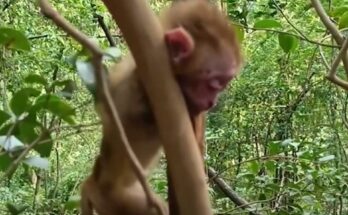Female monkeys, like many other mammals, undergo a labor process when giving birth, and the time it takes for this process can vary significantly depending on the species, individual health, and environmental conditions. On average, the birth process for female monkeys spans several hours, a time frame that reflects the complex interplay of biology, anatomy, and evolutionary adaptations.
The Process of Monkey Birth
In primates, the process of giving birth is similar to that of humans in several ways. The stages of labor—dilation, delivery, and afterbirth—are generally consistent across primate species, though the duration and intensity differ. Female monkeys experience contractions as their bodies prepare to deliver the baby, with the uterus working to push the infant through the birth canal. The time spent in labor varies, but it often takes hours because the process requires careful coordination of the mother’s physical and hormonal systems to ensure the baby’s safe arrival.
Evolutionary Factors
Monkeys, especially those in the Old World monkey family (Cercopithecoidea), often give birth to single offspring at a time. This is an evolutionary strategy that allows for better maternal investment in each infant. However, this focus on single births also means the mother’s body must undergo significant changes to accommodate and deliver the infant, leading to a longer labor period compared to animals that give birth to multiple offspring in a single litter.
The duration of monkey labor is also influenced by their relatively complex anatomy. Like humans, monkeys have a pelvis designed for bipedalism or semi-bipedal postures, which can make the birthing process more challenging compared to quadrupedal mammals. This complexity can extend the time required for the baby to navigate the birth canal.
Social and Environmental Influences
In the wild, female monkeys often give birth within their social groups. The presence of other group members, particularly experienced females, can offer protection and support during this vulnerable time. In some species, other females may assist the laboring mother by providing physical help or simply offering companionship, which can reduce stress and potentially shorten labor.
Environmental factors, such as the availability of safe and secure birthing locations, also play a role. Female monkeys often seek secluded or protected areas to give birth, as the process can make them and their newborns vulnerable to predators. The time spent in labor may increase if the mother needs to frequently change locations or remain alert to external threats.
Challenges and Adaptations
Prolonged labor poses risks to both the mother and the infant, such as exhaustion, difficulty in delivery, or increased exposure to predators. To mitigate these risks, female monkeys rely on adaptations such as strong maternal instincts and efficient recovery systems. For instance, after giving birth, monkey mothers quickly clean and inspect their newborns, ensuring they are ready to nurse and bond.
Additionally, the hours-long labor serves an important purpose: it allows the baby to make necessary adjustments for safe passage through the birth canal. This gradual process reduces the likelihood of injury to the infant or the mother, ensuring higher survival rates for both.
Conclusion
The extended labor period of female monkeys is a testament to the intricacies of primate reproduction. It reflects evolutionary adaptations, social dynamics, and the delicate balance between survival and reproduction in the animal kingdom. While the process may be lengthy and challenging, it ultimately ensures the continuation of species that are critical to the ecosystems they inhabit.


